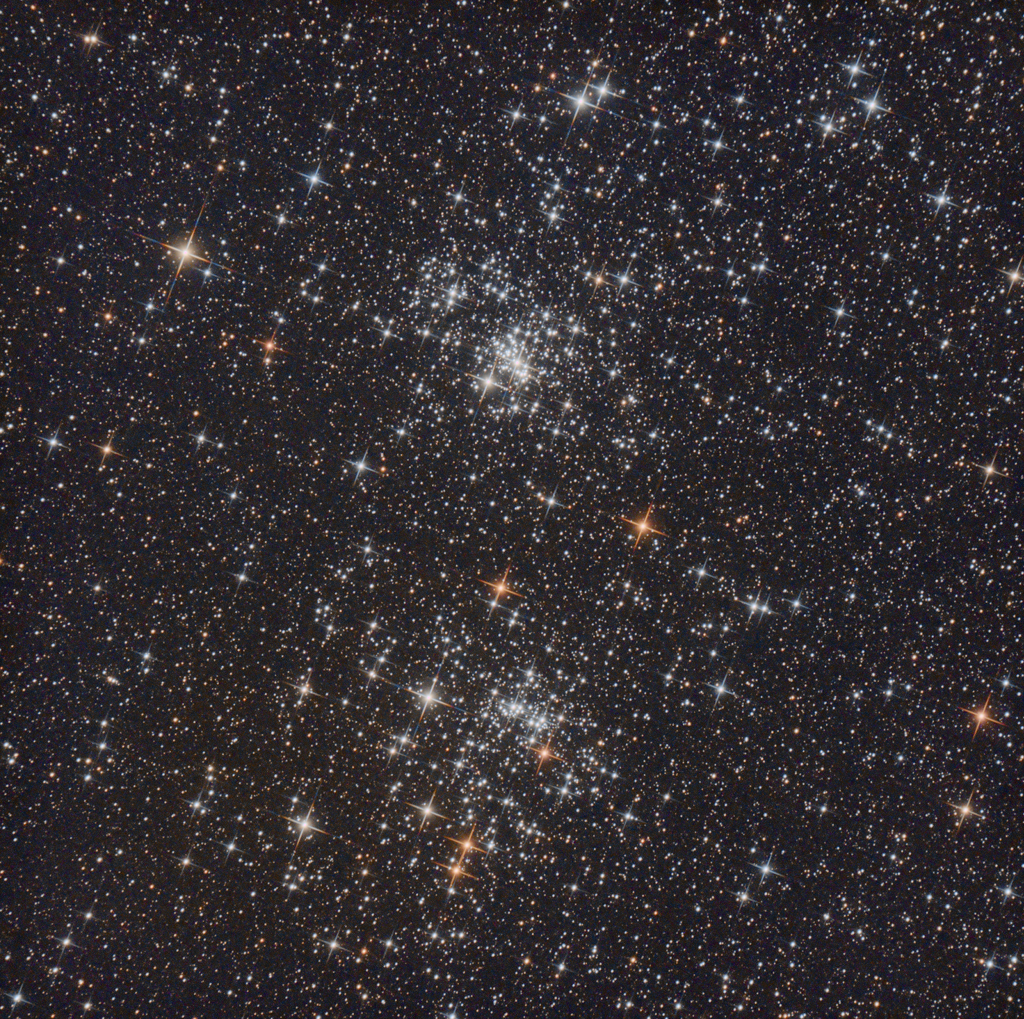08. October 2021
英仙座 ê 雙星團

探索宇宙1!逐工會揀一幅無仝款 ê 影像抑是相片,𤆬你熟似咱這个迷人 ê 宇宙,閣有專業天文學者2為你3解說4。
- 原始文章:The Double Cluster in Perseus
- 影像來源 kah 版權:Jack Groves
- 來參加全球月娘暗會:閣有 APOD 上讚 ê 月娘相片:台灣時間 10 月 10 號拜六透早 6:00 - 9:00
- 台文翻譯:An-Li Tsai (NCU)
[漢羅] 英仙座 ê 雙星團
這个 tī 北方 英仙座 ê 美麗星場有 3 粒月娘遐爾闊(1.5 度闊)。 內底有足有名 ê 一對開放星團,英仙座 η kah χ。 In 嘛去予編做 NGC 869 (頂懸) kah NGC 884。 兩个星團攏是 tī 7000 光年遠 ê 所在,內底攏有比太陽較少年、較高溫 ê 恆星。 兩个星團互相離幾若百光年遠爾爾。 按照 內底 逐粒恆星 ê 年歲來看,兩个星團攏是 1300 歲,表示講 in 是仝一个 恆星形成區 ê 產物。 雙星團若是 tī 較暗 ê 所在,用目睭 to̍h 看有,所以一直攏是 雙筒望遠鏡愛看 ê 目標。 這張充滿活力 ê 望遠鏡景色,是用幾若條 gih-tah ê 弦 tī 彩色恆星影像面頂,產生 繞射光點。
[POJ] Eng-sian-chō ê Siang-seng-thoân
Chit-ê tī pak-hong Eng-sian-chō ê bí-lē seng-tiûⁿ ū saⁿ-lia̍p goe̍h-niû hiah-nī khoah (it-tiám-gō͘ tō͘ khoah). Lāi-té ū chiok ū-miâ ê chit-tùi khai-hòng-seng-thoân, Eng-sian-chō è-thà kah khai. In mā khì hō͘ pian-chò NGC pat-lio̍k-kiú (téng-koân) kah NGC pa̍t-pa̍t-sù. Nn̄g-ê seng-tiûⁿ lóng-sī tī chhit-chheng kng-nî hn̄g ê só͘-chāi, lāi-té lóng-ū pí Thài-iông khah siàu-liân, khah ko-un ê hêng-chhiⁿ. Nn̄g-ê seng-tiûⁿ hō͘-siong lî kúi-ā-pah kng-nî hn̄g niā-niā. Àn-chiàu lāi-té ta̍k-lia̍p hêng-chhiⁿ ê nî-hòe lâi-khòaⁿ, nn̄g-ê seng-thoân lóng-sī chi̍t-chheng-saⁿ-pah hòe, piáu-sī-kóng in sī kâng-chi̍t-ê hêng-chhiⁿ-hêng-sêng-khu ê sán-bu̍t. Siang-seng-thoân nā-sī tī khah-àm ê só͘-chāi, iōng ba̍k-chiu to̍h khòaⁿ-ū, só͘-í it-ti̍t lóng-sī siang-tâng-bōng-oán-kiàⁿ ài khòaⁿ ê bo̍k-piau. Chit-tiuⁿ chhiong-boán oa̍h-le̍k ê bōng-oán-kiàⁿ kéng-sek, sī iōng kúi-ā-tiâu gih-tah ê hiân tī chhái-sek hêng-chhiⁿ iáⁿ-siōng bīn-téng, sán-seng jiàu-siā kng-tiám.
[KIP] Ing-sian-tsō ê Siang-sing-thuân
Tsit-ê tī pak-hong Ing-sian-tsō ê bí-lē sing-tiûnn ū sann-lia̍p gue̍h-niû hiah-nī khuah (it-tiám-gōo tōo khuah). Lāi-té ū tsiok ū-miâ ê tsit-tuì khai-hòng-sing-thuân, Ing-sian-tsō è-thà kah khai. In mā khì hōo pian-tsò NGC pat-lio̍k-kiú (tíng-kuân) kah NGC pa̍t-pa̍t-sù. Nn̄g-ê sing-tiûnn lóng-sī tī tshit-tshing kng-nî hn̄g ê sóo-tsāi, lāi-té lóng-ū pí Thài-iông khah siàu-liân, khah ko-un ê hîng-tshinn. Nn̄g-ê sing-tiûnn hōo-siong lî kuí-ā-pah kng-nî hn̄g niā-niā. Àn-tsiàu lāi-té ta̍k-lia̍p hîng-tshinn ê nî-huè lâi-khuànn, nn̄g-ê sing-thuân lóng-sī tsi̍t-tshing-sann-pah huè, piáu-sī-kóng in sī kâng-tsi̍t-ê hîng-tshinn-hîng-sîng-khu ê sán-bu̍t. Siang-sing-thuân nā-sī tī khah-àm ê sóo-tsāi, iōng ba̍k-tsiu to̍h khuànn-ū, sóo-í it-ti̍t lóng-sī siang-tâng-bōng-uán-kiànn ài khuànn ê bo̍k-piau. Tsit-tiunn tshiong-buán ua̍h-li̍k ê bōng-uán-kiànn kíng-sik, sī iōng kuí-ā-tiâu gih-tah ê hiân tī tshái-sik hîng-tshinn iánn-siōng bīn-tíng, sán-sing jiàu-siā kng-tiám.
[English] The Double Cluster in Perseus
This pretty starfield spans about three full moons (1.5 degrees) across the heroic northern constellation of Perseus. It holds the famous pair of open star clusters, h and Chi Persei. Also cataloged as NGC 869 (top) and NGC 884, both clusters are about 7,000 light-years away and contain stars much younger and hotter than the Sun. Separated by only a few hundred light-years, the clusters are both 13 million years young based on the ages of their individual stars, evidence that they were likely a product of the same star-forming region. Always a rewarding sight in binoculars, the Double Cluster is even visible to the unaided eye from dark locations. But a shroud of guitar strings was used to produced diffraction spikes on the colorful stars imaged in this vibrant telescopic view.
詞彙學習
| 漢羅 | POJ | KIP | 華語 | English |
|---|---|---|---|---|
| 英仙座 | Eng-sian-chō | Ing-sian-tsō | 英仙座 | Perseus |
| 英仙座 χ | Eng-sian-chō khai | Ing-sian-tsō khai | 英仙座 χ | Chi Perseus |
| 英仙座 η | Eng-sian-chō è-thà | Ing-sian-tsō è-thà | 英仙座 η | h Perseus |
| 雙星團 | Siang-seng-thoân | Siang-sing-thuân | 雙星團 | the double cluster |
| 星場 | seng-tiûⁿ | sing-tiûnn | 星場 | starfield |
| gih-tah | gih-tah | gih-tah | 吉他 | guitar |
| 弦 | hiân | hiân | 弦 | string |
| 繞射 | jiàu-siā | jiàu-siā | 繞射 | diffraction |
| 恆星形成區 | hêng-chhiⁿ-hêng-sêng-khu | hîng-tshinn-hîng-sîng-khu | 恆星形成區 | star-forming region |